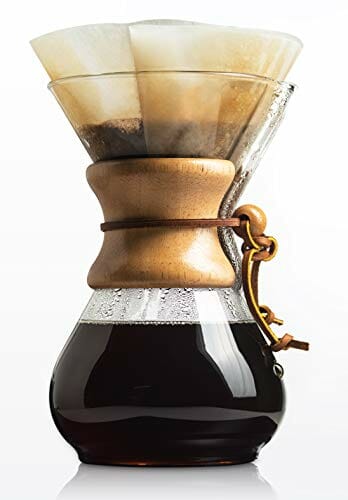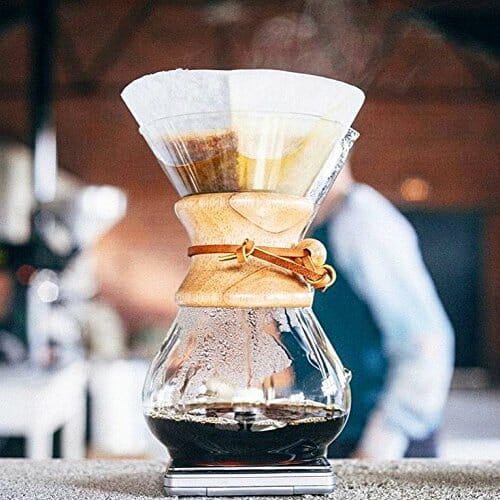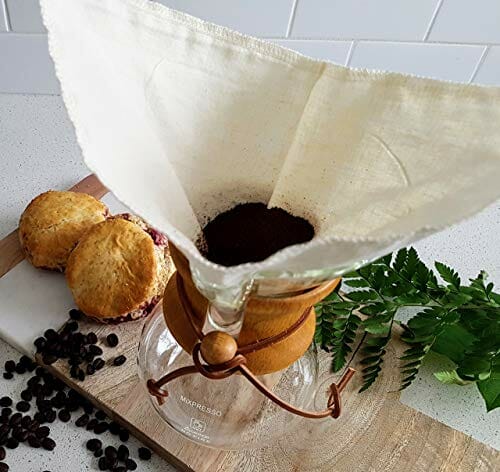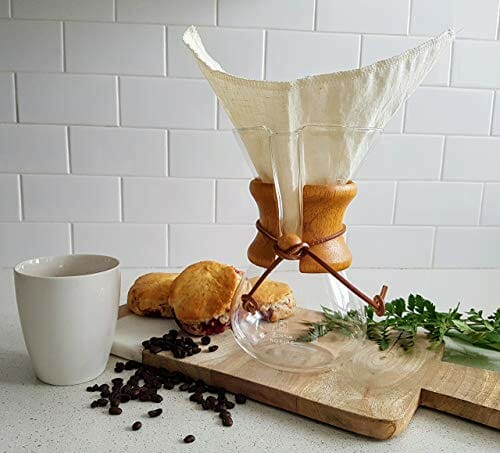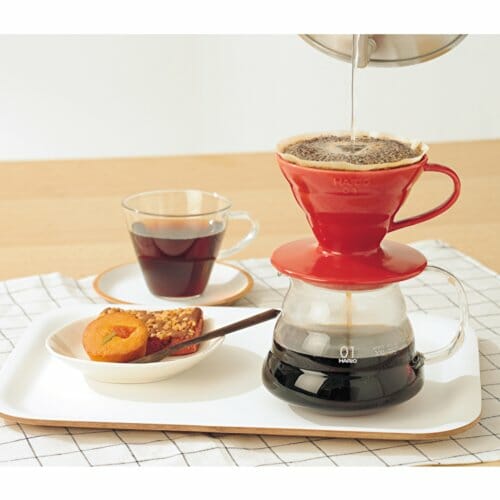Chemex and Hario V60. They’re both Pour-Over coffee makers. Both are loved for brewing coffee that’s clean and smooth thanks to the incorporation of paper filters.
And both have a similar-looking beautiful transparent appearance that effectively shows off the flow of coffee being extracted.
Yet, they still have at least one major difference that makes them unique and suits one barista better than the other.
In this article, I will tell you all about both the Chemex and Hario V60, from what they are, and how to use them, to Chemex vs Hario V60 – how exactly they are same-same but different.
What Is A Chemex Coffee Maker?
As I’ve introduced these coffee makers, Chemex is a gorgeous device that utilizes the Pour-Over method for brewing coffee.
It’s known for its iconic hourglass-shaped beaker with a small funnel-like “waist”, a pretty conical top, and a big and thick wooden collar wrapped around the glass design like a belt.
The collar is, in fact, heatproof. Since the whole piece is made of tempered borosilicate glass, the wooden collar is fitted around the narrowest area, the neck for easy handling and holding when making and pouring coffee.
The collar is held in place by a leather tie or thong that’s loosely hand-tied
Another compelling detail about this glass brewing device is the filter.
Rather than using normal paper filters for making coffee like most Pour-Overs, Chemex requires its own specifically designed bonded filter that’s a lot thicker.
The bonded filter of the Chemex Pour-Over can do a better job at filtering out stray ground coffee, unwanted coffee oils, and bitter flavor notes.
How Was Chemex Invented?
The Chemex was invented in 1941 by Peter Schlumbohm, an eccentric German chemist and inventor who was determined to make everyday objects more functional and entertaining to use with a more charming appearance.
His background and intent led him to invent the double-bonded Chemex filter that’s suitable for making a great cup of Joe with a smooth taste using the Pour-Over coffee brewing method.
The glass carafe was partially inspired by labware that effectively avoids flavor transfer during the process of extraction and over a long time of being in use.
The Chemex is so well constructed in terms of both functionality and outward design that it’s been highly praised and awarded in both the scientific community and the art community.
It was even considered one of the best-designed products of modern times by the Illinois Institute of Technology and displayed at the Museum of Modern Art in 1943.
The Chemex Pour-Over coffee-making device is now being manufactured by the family-owned Chemex Corporation to pass on his legacy.
How To Use A Chemex
Looks great. Sounds great. But how exactly does it make a great cup of coffee to offer more beyond its appearance?
Roast Profile
In terms of roast profiles, you can pretty much use anything if your heart desires it. After all, the best coffee is the one that you find delicious.
But the general consensus among coffee aficionados is that light and medium roasts pair better with the Chemex.
The Pour-Over extraction process of the Chemex makes the coffee-to-bean contact time ideal for bringing out their brighter and more complex flavor profiles.
Brewing dark roasts using a Chemex can draw out the unfavorable burnt or acidic taste as they don’t preserve as many original flavor compounds as lighter roasts.
The thicker filter also discards most of the natural coffee oils, which are what many dark roast drinkers consider to make delicious coffee.
That’s why the French Press, one of the coffee brewers that don’t utilize paper filters, makes such a bomb cup of coffee with darker roasts.
Coffee Grounds Grind Size
The recommended coffee beans grind size for this device is medium-coarse ground coffee.
Different sized coffee grounds have been tested and trialed many times and medium-coarse has been found to be the most suitable for the construction of this Pour-Over coffee brewer.
It guarantees the best water flow rate and extraction of coffee compounds as water is poured and slips through the cracks between coffee grounds into the bottom chamber.
If you want to learn the appropriate size of coffee grounds for other brew methods, check out my ultimate coffee grind chart.
To get the freshest and most consistent grind size for a balanced and high-quality brew, make sure to use a burr grinder on fresh whole beans rather than a blade one. Because the latter can only produce less-than-desirable unevenly cut pieces of coffee beans.
Instructions
And without further adieu, here are some simple instructions on how to brew coffee with a Chemex to help you envision what the process is like.
Step 1: Prepare
- If it’s a traditional full-circle filter, fold it in half twice. Then place your finger between the 2 outer layers to open it into a funnel.
- If it’s a half-moon filter, fold it in half. Fold the tip in. Then fold it in half again.
- Place the folded filter into the Chemex so that the triple-fold part covers the pouring spout.
Step 2: Preheat
- Add hot water to dampen the filter and preheat the brewer.
- Discard the water afterward.
Step 3: Bloom
- Add coffee grounds to the filter and shake to level the ground bed.
- Pour water to wet the grounds and let it bloom for 30 seconds.
Step 4: Brew
- Use a gooseneck kettle to slowly pour water over the grounds in a circular motion. Check out my reviews of the best gooseneck kettles.
- Use 5 oz (148 ml) of water for every tablespoon of coffee.
Step 5: Serve
- Discard the filter.
What Is A Hario V60 Pour-Over Coffee Maker?
Hario V60 is also one of the Pour-Over brewers popular both at coffee shops and at home.
It’s basically just a dripper cone.
But one of the key features that make this different from others in the Pour-Over market today is the signature 60-degree angled cone that it’s structured as.
According to Hario, the Japanese company that came up with this elegant brewer, the cone shape helps lay the ground coffee thicker vertically than a trapezoid dripper.
This allows hot water to take more time flowing toward the center, ensuring a longer and more thorough extraction of good coffee compounds.
Another feature of the Hario V60 that makes a big difference in coffee extraction is the spiral ribs on the inside surface. And, no, they aren’t just there for the aesthetics.
The ribs allow some space between the Hario V60 dripper and the paper filter so that the grounds can have more room to expand and release carbon dioxide during the brewing process. The result is a smooth brew that’s well extracted.
The bottom of the dripper is just a single large exit hole so it won’t restrict the flow of coffee into the carafe below, making the extraction more like a cloth filter.
And, as you could have probably inferred from my explanation of the construct of the Hario V60 above, this belongs to the Coffee brewers that use the coffee filters club.
Check out our full review on the Hario V60 variations here.
History Of V60 Pour Over Coffee

Like I’ve briefly mentioned, Hario V60 was designed and is being manufactured by Hario.
Founded in 1921, it makes lab equipment, especially specializing in those made of glass, and has gone on to manufacture and sell home kitchen tools as well. Its iconic invention wasn’t born until very recently, however.
Back in the 1980s when the trapezoid-shaped coffee drippers were dominating the coffee market in Japan, the designers of Hario were wondering whether the parabolic shape can help with brewing a cleaner cup of coffee.
And that sparked the initial ideas for the Hario V60 which utilized wire rods to support the paper filter. But that couldn’t fight against the wave of instant coffee and mechanical brewers.
So, in 2004, the designers revisited the idea and invented the Hario V60 that I was describing earlier. Its iconic 60-degree V-shaped construct gave it the name that any coffee lover can recognize today.
How To Make Hario V60 Coffee
Roast Profile
Any roast with the Hario V60 can give you the perfect brew you desire.
Depending on your personal preference, go for lighter roasts if you want a brighter taste, and darker roasts if you want a more balanced and deep cup of coffee.
Grind Size
The Hario V60 calls for a tad finer grind. I recommend using the medium-fine grind size based on the filter paper thickness, but anywhere on the medium spectrum should work fine as well.
Hario also recommends using a finer grind if the brew is too weak, and a coarse grind if it’s over-extracted.
Instructions
Follow these simple instructions for brewing a flavorful cup of coffee.
Step 1: Prepare
- Place the dripper over the decanter.
- Place the whole piece on a scale.
- Fold the paper filter and put it in place.
Step 2: Preheat
- Add hot water to dampen the filter and preheat the brewer.
- Discard the water afterward.
Step 3: Bloom
- Add 15 g of coffee grounds to the filter and shake to level the ground bed.
- Pour water to wet the grounds and let it bloom for 30 seconds.
Step 4: Brew
- Use a gooseneck kettle to slowly pour hot water over the grounds in a circular motion in around 2.5 – 3 minutes.
- Pour until the scale reads 250 g.
Step 5: Serve
- Discard the filter.
What Are The Main Differences Between Hario V60 vs Chemex?
Brew
Chemex uses a special bonded filter that’s much thicker than the general everyday filter that Hario V60 uses.
Despite a bit more inconvenience when doing your shopping, the sediment-free cup of Joe that Chemex provides can be worth the hassle.
The glass material also prevents any sort of undesirable flavor transfers from happening, as long as you clean it well.
But, of course, that doesn’t mean Hario V60 can’t produce a clean brew with its normal filters and glass models. That one cup just won’t be as clean.
Overall, both are easy to navigate and take a roughly similar amount of time (a few minutes) to brew. But there’s definitely a learning curve to master the craft of pouring for a better extraction.
Taste
What does Chemex coffee taste like? As I’ve explained earlier, lighter roasts work better with this brewer. You can expect a bright extraction cleaner than anything you’ve ever had, as long as you can pull it off.
Hario V60’s coffee is more balanced with its variety of roast choices. Though it’s also smooth, there is still a subtle difference between the two devices.
Clean
Since they’re Pour-Over, both brewers are generally easy to clean. Toss the filter holding the used grounds and you’ve finished 50% of the dirty job.
You can then wash them with water, soap, and a non-abrasive sponge and leave them to dry until next use. Most of them are dishwasher safe as well, just make sure to check before purchasing.
Once in a while, give them a vinegar bath to remove build-up minerals and oils.
If I have to choose the winner in this round of Chemex vs Hario V60, the latter has to win.
Chemex’s glass material makes it very vulnerable to handle, whereas Hario V60 is available in a range of materials including durable plastic.
Versatility
Though you can hardly make any other type of drink with these devices, you can easily customize your cup by switching up your brewing techniques and ingredients.
Experiment with different coffee roasts and adjust the pouring to explore new coffee tastes.
Portability
I think we all know which one is the winner.
Chemex sacrifices durability for aesthetics with its glass material. Pick the plastic Hario V60 if you want coffee on the go.
Cost
Hario V60 is the more affordable option as it doesn’t cost half as much as a Chemex.
Both are available in multiple cup sizes, but Hario V60 is more suitable for making a single cup.
The smallest size that Chemex comes in is three cups of 5 oz (148 ml) of coffee and the biggest is 10 cups.
You can get Hario V60 in multiple materials from glass and ceramic to plastic models, which is the cheapest. They’re also sold in a few different sizes but the largest one can only cover six cups of Joe.
So, depending on your preference, make the most suitable choice.
Which One Should You Buy: Chemex vs Hario V60?
Pick the Chemex if you crave the clean and smooth coffee taste, love its appearance, frequently make a large batch of coffee, don’t prioritize portability, and don’t mind the hassle of shopping for special filters.
The Hario V60 is for you if you like clean coffee, need more convenience in buying and making coffee, desire more roast variety, love its appearance, portability, and affordability.
For more comparisons, see the differences between V60 and Aeropress here.

![Chemex vs Hario V60: What Makes These Pour-Over Makers Different? [Explained!] 2 Chemex vs Hario V60](https://coffeegeek.tv/wp-content/uploads/2021/10/Chemex-vs-V60-1024x536.jpg)
